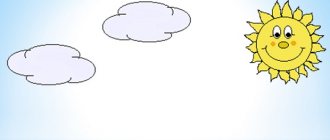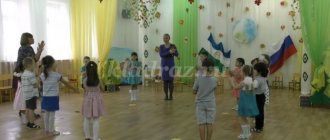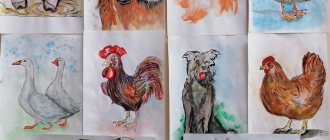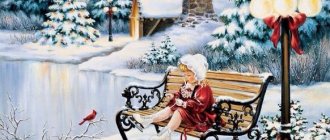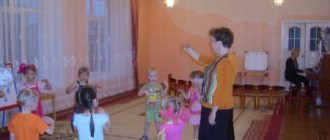Musical lesson in the 1st junior group of the kindergarten “Let's go to the store.”
Goal: creating conditions for development. Objectives: Educational: in a playful way, to consolidate children’s skills in singing, movement, and playing children’s musical instruments; to consolidate interest in music of a different nature, the desire to speak out about it, to recognize songs and plays by melody. Educational: to cultivate love and interest in music. Developmental: develop the imagery of movements and imagination of children; continue to learn to sing expressively with and without musical accompaniment, in a natural voice. Program content:
Material:
Soft toys, dolls.
Progress of the lesson:
Children enter the music room.
There is a display case with toys against the wall. Musical director:
I'm very glad to see you!
Today we are going to the toy store. Do you want to visit there? Then quickly get on the bus! Let's go! Children ride one after another along the carpet to the cheerful music “Bus”.
Musical director: We ended up with you guys in a toy store! What’s not in it! Educator: Ding-ding-ding, ding-ding-ding, Let's open the store! Come in, come in! (Children surround the store counter.)
Look at the doll and take it to your home.
She will love and listen to you, and her name is Katyusha! Musical director: We all buy dolls, we’ll play with them now! The game “Walk with Dolls” is being played, music by T. Lomova // Music and Movement. M., 1981. The teacher reinforces the ability to independently change movements with changing music; distinguish a lullaby, a dance song, for a calm and cheerful walk, hear and convey through movements the change in dynamics, the beginning and end of the music. Achieves expressiveness in the transmission of musical and gaming images. Musical director: It was wonderful you walked with the dolls. Let's sit them on the chairs and see what else is sold in the store. Educator: I am a jumper - a cheerful ball, I don’t like someone who cries.
I don’t love the one who cries, but I love the one who jumps! The teacher has a ball in his hands. Musical director: It’s good that you brought the ball! Have you played enough? No? What a funny ball, it jumps, jumps, jumps! (Children happily catch up with the rolling ball.)
Sit down comfortably, now let's listen to a new song about a ball.
Listen to the song “Ball”, music by A. Oleinikov, lyrics by E. Kudryashov. The children are listening. Performed on DVD player. Musical director: Do you still want to play? Let's imagine that everyone has their own ball. How can you play with it? (Children show: throw it up, down, on the floor, to each other.) That’s right, but you can spin around with it, and swing it over your head, and lift it with your foot on your toes, etc.
Let's play with an imaginary ball. Learning the exercise
“Playing with a ball”, music by A. Petrov // For our children / Comp. A.Dubyanskaya.M. The teacher develops children's imagination, the ability to move musically, rhythmically, and listen to a musical phrase. Musical director: Well done! We came up with interesting moves with the ball. Now let’s sit down, relax and listen to music. What pieces of music have we listened to this year? Which ones would you like to hear? Everyone remembers the names of the plays together. Children choose plays that they would like to hear now. Musical director: Well done! Oh! What are these sounds? Educator: Well, here is a dog, playing with the children, barking very loudly: woof-woof-woof! Musical director: It's a puppy. And his name is... Children: Friend. Musical director: Let's sing a song about him. Children in chorus, with soloists, perform the song “Friend”, well known to them, music and lyrics by E. Suldin . Educator: And the Bear snorted, sniffled, and roared, roared, roared. Musical director: Guys, shall we take the Bear? We know a song about him too. Children perform the song “Bear”, music by I. Boldyrev, S. Makovskaya, lyrics by L. Serostakova . The teacher accompanies the singing by playing on a box, the sound of which is similar to the clatter of hooves. The teacher teaches how to pronounce words correctly, how to accurately intonate a melody, how to sing with and without musical accompaniment, who offers to perform a song with lead singers, who ensures that everyone starts singing immediately after the introduction and takes their breath correctly. Musical director: Well done, they sang well: amicably, cheerfully, easily. Let's see what other toys are in the store. Educator: And I’m a cat, Vaska the cat, Little black eyes. I sing songs to the children: “Bay-bayushki-bay!” Musical director: Vaska the cat, you and I will play: the children will be mice - small, careful, nimble. They will definitely run away from the cat. The game “Vaska the Cat” is played, music by L. Lobachev, lyrics by N. Frenkel. Educator: Here are some more toys: Ratchets, tambourines, rattles... The orchestra will turn out to be big, Play, children, well! Children play in an ensemble to Russian folk melodies. Musical director: Who is this, look? Educator: Shouts Kar-Kar-Kar Makes noise and din. Musical Director: Now it's time to play. Come out into the circle quickly and play more fun. Suggests recalling the Russian folk game "Raven" . Teaches how to dance in a circle and accompany the movement with singing. Musical director: What kind of transport awaits us? Educator: The bus is waiting for us, guys. We need to hurry to kindergarten! Musical director: Indeed! It's interesting in the toy store, but it's time to go to kindergarten! Get on the bus guys! The children leave for the group to the song “Bus”.
